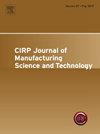Machine learning models for predicting volumetric errors based on scale and master balls artefact probing data
IF 5.4
2区 工程技术
Q2 ENGINEERING, MANUFACTURING
CIRP Journal of Manufacturing Science and Technology
Pub Date : 2025-03-29
DOI:10.1016/j.cirpj.2025.03.003
引用次数: 0
Abstract
The volumetric accuracy of machine tools is important to both machine tool manufacturers and users. Predicting volumetric errors (VEs) is a pre-requisite for their compensation yielding increased dimensional quality of machined parts. However, predicting VEs in five-axis machine tools is challenging due to the complexity of error sources and their associated physics-based model. Machine learning (ML) is used to predict VEs under no load and stable thermal conditions. Data is acquired using a scale and master ball artefact (SAMBA) and on-machine touch probing. A general process for determining the minimum number of balls required to generate data to satisfactorily train an ML model is proposed. The VEs prediction is verified using synthetic data for inter-axis and some intra-axis geometric errors, and then validated using only experimental data. Different datasets based on decreasing number of balls are tested to train either a Neural Networks (NN) or an eXtreme Gradient Boosting (XGBoost) algorithm to compare their performances. The results show that, both NN and XGBoost are effective to predict VEs of a five-axis machine tool with wCBXfZY(S)t topology regardless of the geometric error parameter values. By using only experimental data of twenty balls to train the models, XGBoost outperforms NN in all four error metrics and processing time. A time efficient scheme was tested whereby only two master balls plus one scale bar dataset and an additional master ball (when only the spindle rotates) were used for training NN.
基于尺度和主球人工制品探测数据预测体积误差的机器学习模型
机床的体积精度对机床制造商和用户都很重要。预测体积误差(VEs)是补偿它们以提高加工零件尺寸质量的先决条件。然而,由于误差源及其相关的基于物理模型的复杂性,预测五轴机床中的ve具有挑战性。机器学习(ML)用于预测空载和稳定热条件下的ve。数据是通过一个刻度和主球人工制品(SAMBA)和机器上的触摸探测获得的。提出了一种确定生成数据所需的最小球数以令人满意地训练ML模型的一般过程。利用轴间和部分轴内几何误差的合成数据对预测结果进行了验证,然后仅用实验数据对预测结果进行了验证。测试了基于球数量减少的不同数据集来训练神经网络(NN)或极端梯度增强(XGBoost)算法,以比较它们的性能。结果表明,无论几何误差参数值如何,NN和XGBoost都能有效地预测具有wCBXfZY(S)t拓扑结构的五轴机床的VEs。通过仅使用20个球的实验数据来训练模型,XGBoost在所有四个误差指标和处理时间上都优于NN。测试了一种省时的方案,即只使用两个主球加一个比例尺数据集和一个额外的主球(当只有主轴旋转时)来训练NN。
本文章由计算机程序翻译,如有差异,请以英文原文为准。
求助全文
约1分钟内获得全文
求助全文
来源期刊

CIRP Journal of Manufacturing Science and Technology
Engineering-Industrial and Manufacturing Engineering
CiteScore
9.10
自引率
6.20%
发文量
166
审稿时长
63 days
期刊介绍:
The CIRP Journal of Manufacturing Science and Technology (CIRP-JMST) publishes fundamental papers on manufacturing processes, production equipment and automation, product design, manufacturing systems and production organisations up to the level of the production networks, including all the related technical, human and economic factors. Preference is given to contributions describing research results whose feasibility has been demonstrated either in a laboratory or in the industrial praxis. Case studies and review papers on specific issues in manufacturing science and technology are equally encouraged.
 求助内容:
求助内容: 应助结果提醒方式:
应助结果提醒方式:


